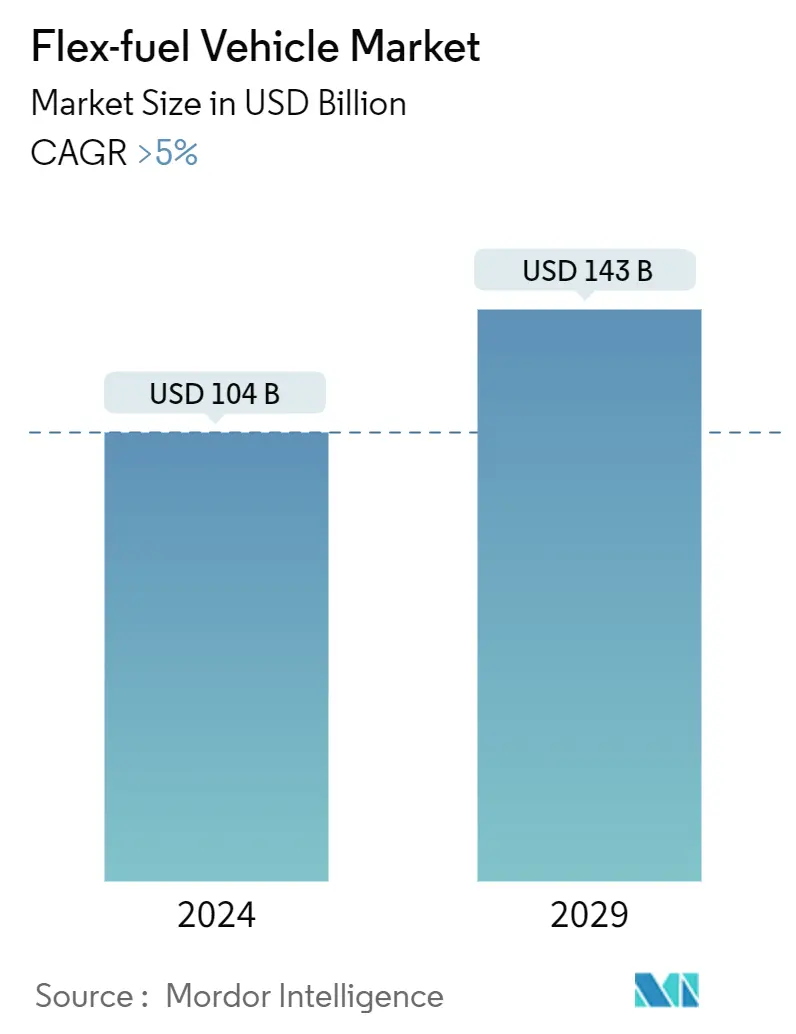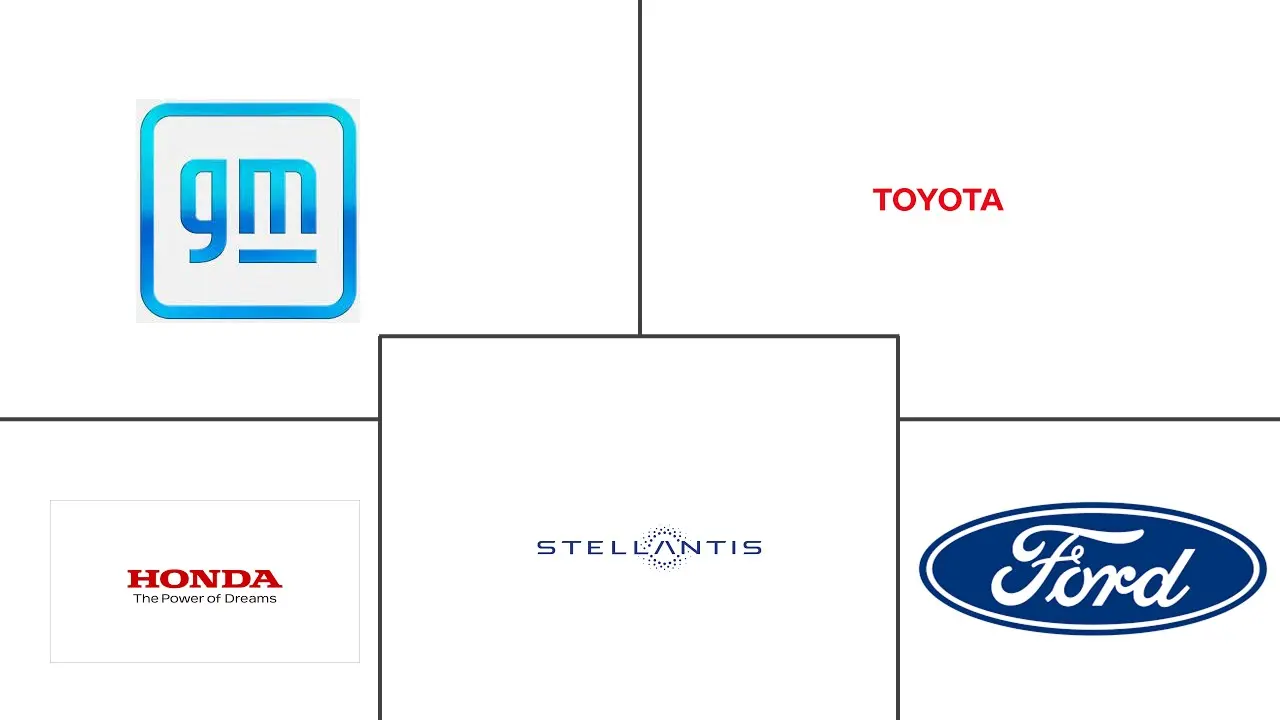Market Size of Flex-fuel Vehicle Industry

| Study Period | 2019 - 2029 |
| Market Size (2024) | USD 104 Billion |
| Market Size (2029) | USD 143 Billion |
| CAGR (2024 - 2029) | > 5.00 % |
| Fastest Growing Market | Asia-Pacific |
| Largest Market | North America |
| Market Concentration | High |
Major Players
*Disclaimer: Major Players sorted in no particular order |
Flex-fuel Vehicle Market Analysis
The Flex-fuel Vehicle Market size is estimated at USD 104 billion in 2024, and is expected to reach USD 143 billion by 2029, growing at a CAGR of greater than 5% during the forecast period (2024-2029).
The market for flex-fuel vehicles (FFV) was not impacted by the COVID-19 pandemic as severely as other automotive industries. However, with limited options for an FFV in the market, it did witness a slight decline in sales, considering the restrictions imposed by the respective governments. However, with the situation easing and life returning to normalcy, the FFV market is anticipated to grow during the projected period.
Most of the vehicles running are fueled using conventional fossil fuels, which has led to an increase in toxic exhaust gas emissions. To control vehicular pollution, multiple county governments have put forth several emission restrictions for IC (internal combustion) engine-powered vehicles. These restrictions have opened the scope for research on vehicles running on flex fuels.
In the market, there are various categories and types of FFV from E10 to E85 and above. According to the tests conducted, FFVs running on E85 fuel produce 23% less NOx, 30% less CO, and 4-6% lower CO2. Due to numerous factors, including reduced tailpipe emissions, domestic production capabilities of ethanol-based fuels, and limiting the use of naturally occurring fossil fuels, the demand for FFVs is expected to increase during the forecast period.
The demand for flex-fuel vehicles is growing significantly in the United States and the Latin American region. It is estimated that more than 84% of the world's ethanol is produced by the United States and Brazil.
Flex-fuel Vehicle Industry Segmentation
Flex-fuel vehicles come under the broad category of alternative fuel vehicles. Vehicles running on ethanol, methanol, and gasoline and alcohol (ethanol or methanol) blended fuels are termed flex-fuel vehicles (FFV).
The flex-fuel vehicle market is segmented by ethanol blend type (e10 to e25, e25 to e85, and e85 and above), vehicle type (passenger cars and commercial vehicles), fuel type (diesel and petrol), and geography (North America, Europe, Asia-Pacific, and Rest of the World).
The report offers the market size and forecasts in terms of value (USD) for all the above segments.
| Ethanol Blend Type | |
| E10 to E25 | |
| E25 to E85 | |
| E85 and Above |
| Vehicle Type | |
| Passenger Cars | |
| Commercial Vehicles |
| Fuel Type | |
| Petrol | |
| Diesel |
| Geography | |||||||
| |||||||
| |||||||
| |||||||
|
Flex-fuel Vehicle Market Size Summary
The flex-fuel vehicle (FFV) market is poised for significant growth over the forecast period, driven by increasing environmental concerns and regulatory measures aimed at reducing vehicular emissions. The market has shown resilience during the COVID-19 pandemic, with a slight decline in sales due to limited vehicle options and government restrictions. However, as these restrictions ease, the market is expected to expand, supported by the growing demand for vehicles that utilize alternative fuels like ethanol. The shift towards FFVs is further bolstered by stringent emission norms in regions such as Europe, where regulations have become progressively stricter, aiming to curb pollutants like NOx and CO2. This regulatory landscape, combined with the benefits of reduced tailpipe emissions and the potential for domestic ethanol production, is expected to drive the adoption of FFVs, particularly in the United States and Latin America, where a significant portion of the world's ethanol is produced.
In the Asia-Pacific region, countries like India and China are emerging as key players in the FFV market, with initiatives to reduce reliance on imported fossil fuels and lower fuel costs. India's Ministry of Road Transport and Highways has set ambitious targets to increase the production and use of ethanol-based fuels, aiming to phase in E10 and E20 fuels in the coming years. This domestic production capability is crucial for meeting the growing demand in a region with a large population. The market is characterized by a consolidated landscape with major automotive players like General Motors, Ford, Toyota, and Honda leading the charge in developing and promoting FFVs. Recent innovations, such as India's introduction of the world's first electric flex-fuel vehicle and Toyota's launch of a 100% ethanol-powered Innova, highlight the industry's commitment to sustainable and cleaner energy solutions. These developments underscore a broader shift towards reducing carbon footprints and embracing alternative fuel sources, aligning with global environmental goals.
Flex-fuel Vehicle Market Size - Table of Contents
-
1. MARKET DYNAMICS
-
1.1 Market Drivers
-
1.1.1 Ratification of Stringent Exhaust Emission Regulations
-
-
1.2 Market Restraints
-
1.2.1 Increase Sales of Electric Vehicle May Restraint the Growth of the Market
-
-
1.3 Porter's Five Forces Analysis
-
1.3.1 Bargaining Power of Suppliers
-
1.3.2 Bargaining Power of Consumers
-
1.3.3 Threat of New Entrants
-
1.3.4 Threat of Substitute Products and Services
-
1.3.5 Intensity of Competitive Rivalry
-
-
-
2. MARKET SEGMENTATION
-
2.1 Ethanol Blend Type
-
2.1.1 E10 to E25
-
2.1.2 E25 to E85
-
2.1.3 E85 and Above
-
-
2.2 Vehicle Type
-
2.2.1 Passenger Cars
-
2.2.2 Commercial Vehicles
-
-
2.3 Fuel Type
-
2.3.1 Petrol
-
2.3.2 Diesel
-
-
2.4 Geography
-
2.4.1 North America
-
2.4.1.1 United States
-
2.4.1.2 Canada
-
2.4.1.3 Rest of North America
-
-
2.4.2 Europe
-
2.4.2.1 Germany
-
2.4.2.2 France
-
2.4.2.3 Spain
-
2.4.2.4 United Kingdom
-
2.4.2.5 Rest of Europe
-
-
2.4.3 Asia-Pacific
-
2.4.3.1 China
-
2.4.3.2 India
-
2.4.3.3 South Korea
-
2.4.3.4 Japan
-
2.4.3.5 Rest of Asia-Pacific
-
-
2.4.4 Rest of the World
-
2.4.4.1 South America
-
2.4.4.2 Middle East and Africa
-
-
-
Flex-fuel Vehicle Market Size FAQs
How big is the Flex-fuel Vehicle Market?
The Flex-fuel Vehicle Market size is expected to reach USD 104 billion in 2024 and grow at a CAGR of greater than 5% to reach USD 143 billion by 2029.
What is the current Flex-fuel Vehicle Market size?
In 2024, the Flex-fuel Vehicle Market size is expected to reach USD 104 billion.

